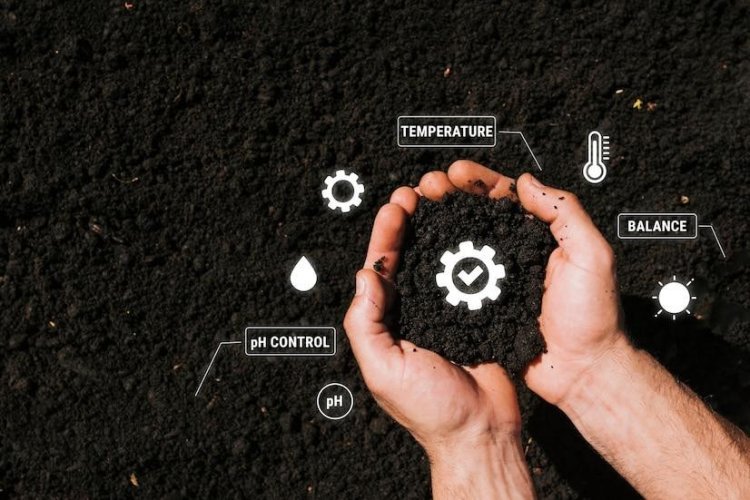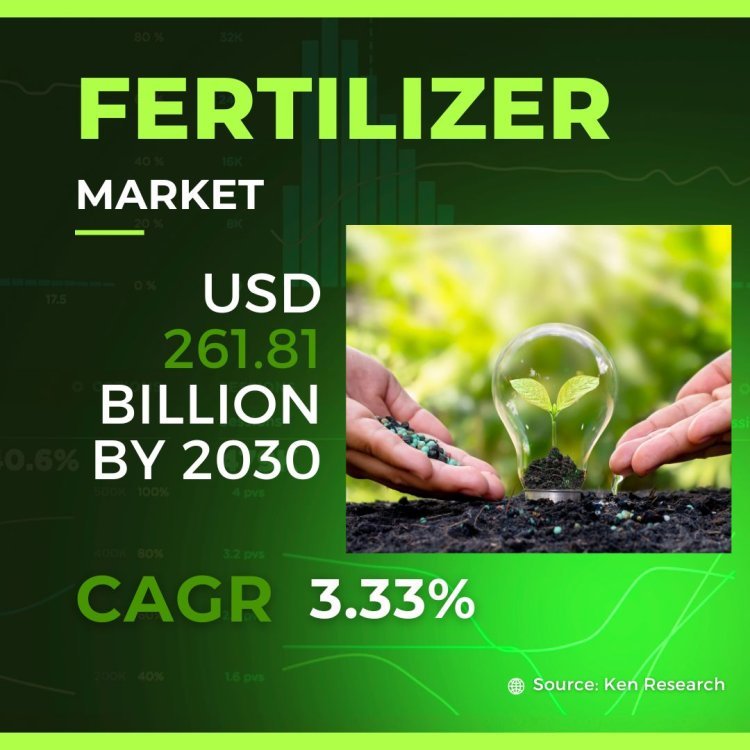Your Guide to the Evolving Fertilizer Market: Growth, Challenges, and Greener Solutions
The global fertilizer market is a multi-billion dollar powerhouse, projected to reach a staggering USD 261.81 billion by 2030, with a Compound Annual Growth Rate (CAGR) of roughly 3.33%.

As a fertilizer market research analyst, I delve deep into the intricate world of crop nutrition. This blog delves into the current state of the fertilizer market, analysing its size, growth, key trends, and challenges. Whether you're an established player, an innovative startup, or a keen investor, this analysis aims to equip you with the knowledge to navigate this fertile ground for opportunity.

Market Size and Growth Projections
The global fertilizer market is a multi-billion dollar powerhouse, projected to reach a staggering USD 261.81 billion by 2030, with a Compound Annual Growth Rate (CAGR) of roughly 3.33%. This robust growth can be attributed to several key drivers:
- Rising Global Population: A burgeoning population necessitates increased food production, driving demand for fertilizers to enhance crop yields.
- Shifting Dietary Patterns: The growing preference for meat-based diets, particularly in developing economies, fuels demand for grains used in animal feed, further pushing fertilizer consumption.
- Depleted Soil Fertility: Intensive agricultural practices can deplete essential soil nutrients over time, making fertilizers crucial for replenishing these elements and maintaining soil health.
Market Segmentation: Diverse Solutions for Specific Needs
In the expansive realm of the fertilizer market, segmentation plays a pivotal role in understanding the diverse needs of agricultural sectors, regions, and crop varieties. Let's delve into the intricate segmentation of this dynamic market:
1. Type of Fertilizers:
-
Nitrogen Fertilizers:
- Widely used for promoting leafy green growth and overall plant vigor.
- Examples: Urea, Ammonium Nitrate, Ammonium Sulfate.
-
Phosphorus Fertilizers:
- Essential for root development, flowering, and fruiting stages.
- Examples: Single Super Phosphate (SSP), Triple Super Phosphate (TSP), Diammonium Phosphate (DAP).
-
Potassium Fertilizers:
- Vital for overall plant health, disease resistance, and water uptake.
- Examples: Potassium Chloride (Muriate of Potash), Potassium Sulfate.
-
Micronutrient Fertilizers:
- Address specific nutrient deficiencies in crops, enhancing yield and quality.
- Examples: Zinc, Boron, Iron, Copper, Manganese.
-
Organic Fertilizers:
- Derived from natural sources, promoting soil health and sustainability.
- Examples: Compost, Manure, Biofertilizers.
2. Crop Type:
- Cereals and Grains:
- Includes crops like wheat, rice, maize, barley, and oats.
- Oilseeds:
- Includes crops like soybeans, sunflowers, canola, and peanuts.
- Fruits and Vegetables:
- Includes a wide variety of fruits, vegetables, and tubers with specific nutrient requirements.
- Cash Crops:
- Includes crops grown for commercial purposes such as cotton, sugarcane, coffee, and tea.
- Pulses and Legumes:
- Includes crops like lentils, chickpeas, beans, and peas.
3. Method of Application:
- Broadcasting:
- Uniform application across the entire field, suitable for crops with similar nutrient requirements.
- Foliar Spray:
- Direct application to the leaves, providing quick absorption and addressing immediate nutrient deficiencies.
- Fertigation:
- Integration with irrigation systems, delivering precise nutrients to the root zone as needed.
- Seed Treatment:
- Coating seeds with fertilizers to provide nutrients during germination and early growth stages.
- Soil Application:
- Incorporating fertilizers into the soil before planting, ensuring gradual release of nutrients over time.
4. Geographical Segmentation:
- Regional Preferences:
- Varying soil types, climate conditions, and crop patterns influence fertilizer choices.
- Examples: Tropical regions may require more potassium for fruiting crops, while temperate regions benefit from nitrogen-rich fertilizers for grains.
- Market Demand by Region:
- Markets such as Asia-Pacific, North America, Europe, and Latin America exhibit distinct preferences and consumption patterns.
- Emerging Markets:
- Rapidly growing agricultural sectors in countries like India, China, Brazil, and Nigeria present significant growth opportunities.
5. End-User Segmentation:
- Large-Scale Farms:
- Commercial farming operations with extensive land holdings and mechanized practices.
- Smallholder Farmers:
- Subsistence farmers cultivating smaller plots of land, often with limited access to resources.
- Agribusinesses:
- Companies involved in agricultural production, processing, and distribution, requiring specialized fertilizers.
- Gardens and Landscaping:
- Residential and commercial properties using fertilizers for ornamental plants, lawns, and gardens.
- Research and Development:
- Institutions and laboratories developing new fertilizers, testing formulations, and studying soil nutrition.
6. Product Formulation:
- Granular Fertilizers:
- Slow-release formulations for sustained nutrient availability.
- Liquid Fertilizers:
- Quick-acting solutions for immediate nutrient uptake.
- Powdered Fertilizers:
- Versatile formulations suitable for various application methods.
- Specialty Blends:
- Customized formulations catering to specific crop requirements or soil deficiencies.
7. Market by Application:
- Agriculture:
- Dominates the market, encompassing crop cultivation, horticulture, and plantation crops.
- Gardening and Landscaping:
- Residential, commercial, and public spaces utilizing fertilizers for aesthetics and plant health.
- Sports Turf and Golf Courses:
- Maintaining lush, healthy turf using specialized fertilizers for sports fields and golf courses.
- Forestry and Nurseries:
- Nurseries producing seedlings, saplings, and ornamental trees requiring nutrient-rich soils.
8. Environmental Considerations:
- Organic vs. Synthetic:
- Growing preference for organic fertilizers due to environmental sustainability and consumer demand.
- Nutrient Runoff and Pollution:
- Awareness of the impact of excess fertilizers on water bodies, leading to regulations and eco-friendly formulations.
- Soil Health and Microbial Balance:
- Focus on maintaining soil fertility, organic matter, and beneficial microbial populations for sustainable agriculture.
The Intertwined Crop Protection Market
The fertilizer market is intricately linked to the crop protection market, estimated to reach a value of USD 137.3 billion by 2027. This market encompasses solutions like insecticides, herbicides, and fungicides that shield crops from pests, diseases, and weeds. Understanding this interconnectedness is crucial, as integrated solutions are becoming increasingly sought after by farmers to optimise both crop protection and nutrition.
A Global Mosaic: Regional Variations in Growth and Consumption
The global fertilizer market exhibits regional variations in terms of growth and consumption patterns:
- Asia Pacific: This region leads the global fertilizer market, driven by factors like increasing population, rising disposable income, and government initiatives promoting agricultural productivity. China and India are the key players in this region.
- North America: A mature market with high fertilizer consumption, North America is focusing on developing sustainable and efficient fertilizer application methods.
- Europe: The European fertilizer market is experiencing moderate growth, with an emphasis on environmental regulations and controlled-release fertilizers.
- Latin America: This region is expected to witness significant growth in fertilizer consumption due to expanding agricultural production.

Shaping the Future of the Fertilizer Landscape
Several key trends are shaping the future of the fertilizer market:
- Precision Farming: The adoption of precision farming techniques allows for targeted application of fertilizers, maximising efficiency and minimising environmental impact.
- Focus on Sustainability: Environmental concerns are driving the development of slow-release and organic fertilizers that minimise environmental damage. The organic fertilizer market, a niche segment expected to reach USD 196 million by 2028 Research says, is experiencing significant growth.
- Government Regulations: Governments around the world are implementing stricter regulations to control the use of fertilizers and promote sustainable practices.
Challenges and Opportunities
The fertilizer market faces several challenges:
- Fluctuating Raw Material Prices: The cost of key fertilizer ingredients like natural gas and potash can be volatile, impacting production costs and profitability.
- Geopolitical Instability: Global conflicts can disrupt supply chains and fertilizer availability in certain regions.
- Climate Change: Extreme weather events can disrupt agricultural production and fertilizer demand.
However, amidst these challenges, exciting opportunities exist:
- Technological Advancements: Investment in R&D can lead to the development of more efficient fertilizer formulations and application methods.
- Emerging Markets: Developing economies present significant growth potential for the fertilizer market as they strive to increase agricultural output. Companies that can cater to the specific needs of these regions are well-positioned for success.
Conclusion
The fertilizer market is a complex ecosystem, but with the right knowledge, it can be a fertile ground for growth. By delving deeper with Ken Research, you'll gain the insights needed to cultivate a thriving future in a transformative agricultural landscape. Let's grow together.
What's Your Reaction?









![Wireless Connectivity Software Market Size, Share | Statistics [2032]](https://handyclassified.com/uploads/images/202404/image_100x75_661f3be896033.jpg)


